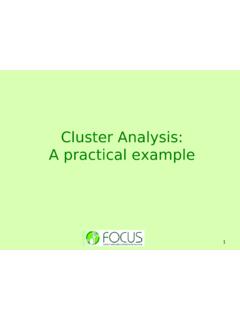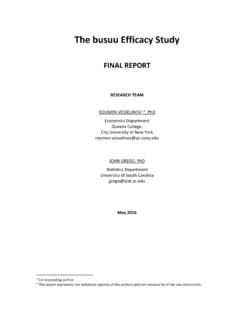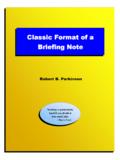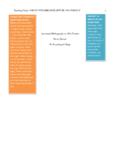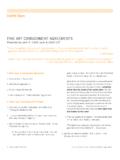Transcription of Theories of consumer behavior and methodology …
1 Theories of consumer behavior and methodology applied in research of products with H&N claimsGaljina Ognjanov, PhDFaculty of Economics University of BelgradeTraining on theoretical basis and top current methods in food consumer science: Food products with nutrition and health claimsBecici 12-13 October, 2009 Presentation outline Part I: General insight into food consumer research Part II: Theories and methodology used in consumer research related to food products with N&H claims ExercisePresentation goals: what you may expect to gain at the end Reminder of consumer research process Reminder of other Theories used in food consumption science Explanation of Theories most frequently referred to in consumer research related to N&H claim products Explanation of experimental research design most frequently applied in consumer research related to N&H claim productsGeneral insight into food consumer researchLets have a brief look into how and what do we research !
2 Part I: How do we research ? Stepwise research approach (Dr Ivo A. van der Lans)Developing research objectives and questionsSecondary data collection, theoretical background, research model and hypothesisDesigning primary research , research strategy, designData collection and statistical analysisReport writing, discussion and conclusions, implicationsWHY?WHAT?HOW?HAVE?KNOW?DO?Pa rt I: What do we research ? consumer motivation Personality: personal characteristics, image consumer perception consumer learning Attitude formation and change Communication Decision making Socio-demographic, economic , cultural, psychological factors influencing consumer behavior SegmentationPicture source: I: What Theories are applicable? (1/2)Many Theories and models applicable: Food choice Theories Health behavior Individual and Collective change Quality perception Information processing consumer learning Communication Attitude formation/change.
3 These Theories belong to a number of fields: Sociology, Psychology, Economics, Marketing Health Science ..Part I: What Theories are applicable (2/2) List of Theories already explained in the previous training sessions (Kees de Graf and Dr Siet Sijtsema) Application tailored nutrition communication Health consciousness/Health locus of control Food choice questionnaire Taste and health attitude questionnaire Food neophobia/variety seeking Theory of planned behavior Stages of change Total food quality modelPart II: consumer research related to food products with N&H claimsLlets have a detailed look into Theories and methodology usedPart II: What makes research of food products with N&H claims specific? Variety of Theories of consumer behavior applicable in scientific research Many Theories referred to during prior trainings Most of them are used for explaining food consumption in general and can also be used in research of products with N&H claims consumer research of products with N&H claims is specific Therefore it requires referring to another set of Theories related to consumer learning and attitude formation and changeWhat makes research of food products with N&H claims specific?
4 By including a N&H claim manufacturers communicate N&H benefits Such a claim can be applied on various food categories (organic, traditional, fruit etc) however here we deal only with functional food consumer research related to this food category focuses on a number issues related to various effects of food labeling relevant for policy makers, consumers and marketersPart II: Products with N&H claims food consumer science interestBroad field of research dedicated mostly to explaining how N&H claims and Nutrition Fact Panes influence:1)Consumers perception (perceived importance of the nutrient, perception of disease risk), health beliefs, nutrition awareness and knowledge, label understandability and usage2)Trust in N&H claims, product evaluations, manufacturers credibility, attitudes toward the brand and purchase intention 3)Actual consumption (raises the question of obesity)Part II: Products with N&H claims food consumer science theoretical backgroundConsumer learning and attitude formation and change economic search for information Elaboration Likelihood Model Expectancy value theory Dual mediation hypothesis Other relevant Theories : Hierarchy of effects models AIDA, Prospect theory, Schema congruity theory, Affect transfer hypothesis, Framework of how low fat nutrition claims influence consumptionPart II: economic model of search for information economic model of search for information (Stigler, 1961): consumer will continue to acquire and process information so long as the cost of additional acquisition and processing do not outweigh the potential benefits.
5 The amount of search varies among individuals due to their expenditure level on commodity, the cost of search and perceived benefits. Cost of search is tied to consumers time. They have to invest time in finding information. As time is a limited resource they will have to reallocate it from other everyday duties. Connected to it are their opportunity costs lost wages, sacrificed leisure search for information: a framework in context of N&H productsNutrition claims and health claims convey messages that may initiate further search for informationAdditional information may be obtained from Nutrition Fact Panel and/or other explanations (claim, disclaimers, references etc) provided on the food packagingThe question is will the consumers decide to use those information prior to making their choice on particular food product or brand?(See eg: Nayga, R, Lipinski, D, Savur, N, Consumers Use of Nutritional Labels while Food Shopping and at Home, The Journal of consumer Affairs, Vol.)
6 32, No. 1, 1998, pp. 106-120 Part II: Elaboration likelihood model Belongs to Theories of consumer learning and attitude formation and change (Petty and Cacioppo, 1986) Explains how the classic source, message, recepient and contextual variables have an impact on attitudes toward various objects, issues and people (ie. How external and internal variable have an impact on evaluative (good vs bad) and non-evaluative (likely vs non likely) judgements. The theory articulates a finite number of ways in which variables can have their impact on judgments, it also specifies when variables take on these roles, as well as the consequences resulting from these likelihood model ELM uses dual routes (central and peripheral) to explain attitude change (persuasion) based on different degrees of elaborative information processing activity. Suggests that a person s level of involvement during message processing is critical in determining which route to persuasion is likely to be likelihood model Explanation in context of products with N&H claims: Purchase of product with N&H claim perceived of a high risk (high involvement condition): people will be more willing to expand their cognitive effort required to process the message arguments.)
7 They will follow central route and base their attitude or choices on the message arguments (Nutrition Pact panel). Purchase of product with N&H claim perceived of a low risk (low involvement condition) they follow the peripheral route and rely more heavily on other message elements (visualized and verbalized benefits: pictures, models, claims).Elaboration likelihood model Elaboration likelihood model research findings (see eg: Garretson, and Burton, S, Effects of Nutrition Fact Panel Values, Nutrition Claims and Health Claims on consumer Attitudes, Perception of Disease Related Risk and Trust, Journal of Public Policy and Marketing, (2), 2000, pp. 213 -227) Not all N&H claims involve equal degrees of elaborative information processing activity. Perceived importance of a claim will affect further search for information. Two nutrient claims Low fat and High in fiber are perceived not equally diagnostic.
8 Prospect theory: value associated with a perceived loss is greater or more salient than value associated with a gain (Tversky and Kahneman 1981)Part III: Expectancy value theory EVT (Fishbein, 1970, Fishbein and Ajzen, 1975): explains and predicts individual s attitudes toward objects and actions. Later expanded into TRA and TBP. Attitudes are developed and modified based on assessments of beliefs and values. Three components:1) response to information through developing a belief 2) assigning value to each attribute that the belief is based on 3) an expectation is created or modified based on result of calculation of beliefs and values nA = bi vi i=1 Expectancy value theoryExplanation in context of products with N&H claims: Attitudes toward an object are a function of the desirability of perceived consequences that might occur. Example: For the claim Low Fat one may expect not to be tasteful. If a person values the perceived taste of the food low (not desirable) he/she may have negative expectation of the food experience.
9 On contrary, if the perceived food attribute (taste) is positive and highly valued it will lead to positive expectation which may be proved or challenged through his/hers real experience with the value theoryExpectancy value theory implications for advertisers: Food advertising claims consistent with product attributes/benefits that are desirable and highly valued by consumers are the most : Schema congruity theoryAdvertising claims that are incongruent with the typical product category schema are more persuasive than a claim matching the product schema as long as the extreme incongruity between the product and the advertising claim can be avoidedResearch interest Expectancy value theory vs. Schema congruity theoryTastes like a real butterWill a nutrition/health claim really lead to product trial, purchase, consumption?Part II: Dual mediation hypothesis Credited to Mackenzie and Lutz, 1980s Examines structural relationships among three constructs: attitude toward the ad (Aad), attitude toward the brand (Ab) and purchase intention (PI), most frequently used for measuring communications effectivenessCaAadCbAbPICa advertising cognitions, Cb brand cognitions, Aad attitude toward ad, Ab attitude toward brand, PI purchase intentionDual mediation hypothesis Application in research of N&H claim products Attitude toward the ad (claim), which is affected by ad related cognitions, has a direct impact on attitude toward a brand (using the claim) further leading to formation of purchase intentions.
10 Additionally, Aad also affects brand cognitions thus indirectly influencing Ab and PI. Linked to ELM: Dual Mediation Hypothesis vs. Affect transfer , DMH and ATHS ource: Sicilia, M, Ruiz, S, Reynolds, N, Attitude formation online, International Journal of Market research , Vol. 48 (2), 2005 Part II: methodology applied in consumer research related to products with N&H claim Focus groups In depth interviews Content analysis Survey ExperimentExperimental design Experiments are used to measure casual relationships of independent and dependent variables. Independent variables are manipulated through allocating experimental subjects into two or more experimental groups. Experimental group receives experimental treatment. The dependant variables (eg. Aad, Ab, PI) are measured according to various experimental treatments or in an absence of it (control group). Experiments can be: field experiments, laboratory experiments, quasi experimentsExperimental design Examples from studies related to N&H claim productsPaper: Hooker, , Teratanavat, R, Dissecting Qualified Health Claims: Evidence from experimental studies , Critical Reviews in Food Science and Nutrition, Vol.
